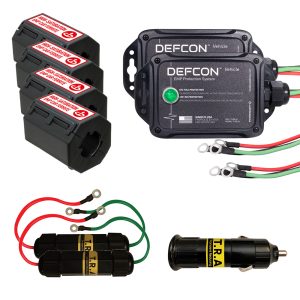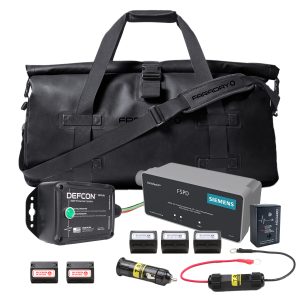EMP
What is an Electromagnetic Pulse (EMP)?
An EMP is an intense, broadband burst of electromagnetic energy. It can be the result of many things, including lightning, a nuclear explosion, or specialized weapons. Each is briefly discussed below.
- Lightning—Many people are familiar with the “buzz” or “pop” that can be heard in electronic systems when a nearby lightning strike occurs. Most of the time, the resultant electromagnetic wave is not sufficiently strong enough to cause permanent damage but might instead reset computers or cause some other noticeable (but temporary) malfunction.
- Nuclear Explosion—Electromagnetic waves are generated as a byproduct of a nuclear explosion. If the detonation is high in the atmosphere, the waves can propagate down to the surface and damage electronic hardware across a very large area. A high-altitude nuclear EMP attack is viewed as a serious national threat and is, therefore, the main focus of this chapter.
- Specialized EMP Weapons—Military weapons have been created with the sole purpose of generating disruptive EMPs. Some are directed-energy weapons that use high-powered microwaves (HPM) to emit high-frequency electromagnetic energy. Others are E-bombs built around conventional explosives teamed with pre-charged electronic circuits. Two widely cited EMP weapons are the explosively pumped coaxial flux compression generator (FCG) and the virtual cathode oscillator vircator). Weapons of this type are typically used for disrupting electronics in localized areas, such as across a military compound.
Of these three sources, the EMP that results from a nuclear explosion has the greatest potential to cause widespread damage to our country. When people discuss an “EMP attack,” they are almost always referring to one that is a result of a high-altitude nuclear detonation.
Relevant EMP-Related Standards
- MIL-STD 188-125-1 HEMP Hardening (Fixed Facilities)
- MIL-STD 188-125-2 HEMP Hardening (Transportable Systems)
- MIL-STD 202 Environmental Requirements Component Level
- MIL-STD 810 Environmental Requirements Box Level
- MIL-STD 461 EMI Requirements (Subsystems)
- MIL-STD 464 EMI Requirements (Systems)
- RTCA DO-160F Aircraft Protection
- UL1449 Safety Standards for Low Voltage Surge Protective Devices
- IEEE/ANSI C62.41 Product Application Location, Test Methods, Guide to using the standard
- IEC Standards International Electrical Committee
Showing 1–16 of 41 results
-

DEFCON™ Home Switch – NEW
$589.00 Buy Now -

DEFCON™ Pulse Tag – Personal EMP Detection System – NEW
$79.99 Buy Now -
Sale!

Heavy Duty EMP Vehicle Cover – NEW
Price range: $6,791.50 through $8,491.50 Buy Now -

JACKET Pro Faraday CORDURA® Laptop Bag – Magnetic Closure (9.5″ x 13″) – NEW
$89.99 Buy Now -

JACKET Pro Faraday CORDURA® Laptop XL Bag – Magnetic Closure (14″ x 17″) – NEW
$129.99 Buy Now -

JACKET Pro Faraday CORDURA® Phone Bag – Magnetic Closure (8.5″ x 4.5″) – NEW
$54.99 Buy Now -

JACKET Pro Faraday CORDURA® Tablet Bag – Magnetic Closure (9″ x 10.5″) – NEW
$74.99 Buy Now -

JACKET Pro Faraday CORDURA® Vertical Phone Bag – Magnetic Closure (4.5″ x 8″) – NEW
$47.99 Buy Now -

T.R.A.P.-OBD2™ EMP Vehicle Protection
$85.00 Buy Now -
Sale!

EMP Tractor/Recreational Vehicle Protection Kit
Original price was: $255.00.$235.00Current price is: $235.00. Buy Now -

Faraday Anti-Theft Key Fob Dry Bag
$21.99 Buy Now -
Sale!

Tablet Black PU Leather Privacy Bag 7.5″ x 10″
Original price was: $30.00.$19.55Current price is: $19.55. Buy Now -
Sale!

Two DEFCON™ Vehicles + EMP Diesel Vehicle Protection Kit
Original price was: $1,400.00.$1,275.00Current price is: $1,275.00. Buy Now -
Sale!

Ultimate EMP Kit – Complete Auto and Home Protection
Original price was: $1,925.00.$1,725.00Current price is: $1,725.00. Buy Now -

SIEMENS Boltshield™ FSPD140 w/ Mounting Bracket
$360.00 Buy Now -
Sale!

EMP Diesel Vehicle Protection Kit (Two Batteries)
Original price was: $595.00.$535.00Current price is: $535.00. Buy Now
